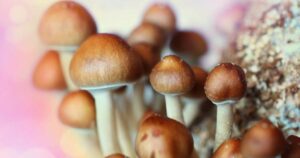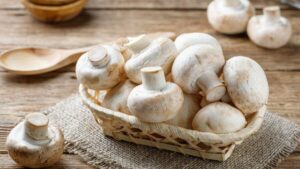Notable Elements
Mushroom Basics: Mushrooms are fungi found in various shapes and colors, playing a vital role in ecosystems as decomposers. Some are edible, while others are poisonous.
Reproductive System: Mushrooms reproduce through microscopic spores dispersed in the air or by other means to find suitable environments for growth.
Medicinal Properties: Certain mushrooms have medicinal properties, including antimicrobial and anti-inflammatory effects, and have been used in traditional medicine.
Magic Mushrooms (Psilocybin): Magic mushrooms contain psilocybin, a psychoactive compound, inducing altered states of consciousness, euphoria, and potential therapeutic benefits.
Regular Mushrooms (Culinary): Regular mushrooms, like button, shiitake, and portobello, are edible and known for their nutritional value, versatile culinary uses, and health benefits.
Chemical Composition: Magic mushrooms contain psilocybin, while regular mushrooms do not have hallucinogenic compounds.
Effects: Magic mushrooms can alter perception and induce hallucinations, while regular mushrooms offer nutrients and health benefits.
Legal Status: Magic mushrooms’ legality varies; they are controlled substances in many places. Regular mushrooms are generally legal for consumption.
Cultural and Spiritual Significance: Magic mushrooms have historical use in spiritual and ceremonial contexts, while regular mushrooms are commonly used in cooking.
Safety: Caution is advised when consuming magic mushrooms due to potential risks, including psychological distress. Legal consumption should only occur in safe environments and under expert guidance.
Introduction
Mushrooms are a form of fungus that belongs to the kingdom Fungi. They are diverse organisms of various shapes, sizes, and colors. They are non-photosynthetic, meaning they do not use sunlight to produce energy.
Mushrooms play a crucial role in the ecosystem as decomposers, breaking down organic matter and recycling nutrients into the soil— found in various habitats, including forests, grasslands, and even on decaying trees or logs. There are thousands of mushroom species— some are edible and widely consumed as food, while others are poisonous and even deadly if ingested.
Mushrooms have a unique reproductive system. They reproduce by releasing spores, which are microscopic cells that are similar to seeds. These spores are dispersed into the air or via other means, such as the wind or animals, to find a suitable environment for growth.
Besides their ecological importance and culinary value, mushrooms are known for their medicinal properties. Some species have antimicrobial, anti-inflammatory, and antioxidant properties and have been traditional medicine for centuries.
Moreover, certain mushrooms, such as the hallucinogenic psilocybin mushroom, have been used for recreational and spiritual purposes. These mushrooms contain psychoactive compounds that may induce altered states of consciousness when consumed. So, what are the differences between regular and psilocybin mushrooms? Let us see.
What are magic mushrooms and their properties?
Magic mushrooms, scientifically known as Psilocybin mushrooms, are a naturally occurring type of mushroom that contains the psychoactive compound psilocybin.
These mushrooms have been used for centuries in various cultures for their hallucinogenic properties and have gained popularity in recent years for their potential therapeutic benefits.
When consumed, magic mushrooms can induce a range of psychological effects, such as altered perceptions, intense sensory experiences, and spiritual or mystical experiences. The psychedelic experience produced by these mushrooms is often referred to as a “trip” and can last several hours.

Some properties of magic mushrooms include:
- Psychoactive Effects: Psilocybin mushrooms are known for their hallucinogenic properties, altering a person’s perception, thoughts, emotions, and senses. Users often experience intense visual and auditory hallucinations.
- Mood Enhancement: Magic mushrooms can induce euphoria, happiness, and creativity. Some users may also experience a sense of spiritual or mystical connection.
- Altered Consciousness: The consumption of magic mushrooms can result in an altered state of consciousness. Users often report a distorted sense of time, enhanced introspection, and a profound connection with one’s surroundings.
- Potential Therapeutic Uses: Recent studies have shown that psilocybin, the active compound in magic mushrooms, may have therapeutic potential for treating mental health conditions such as depression, anxiety, and post-traumatic stress disorder. It is a potential treatment option in controlled clinical settings.
- Duration and Dosage: The effects of magic mushrooms typically begin within 20-60 minutes after consumption and can last for about 4-6 hours. The intensity of the experience depends on the dosage, with higher doses resulting in more profound effects.
- Safety Considerations: While magic mushrooms are generally considered safe for consumption, they can produce unpredictable effects and some individuals may experience anxiety, paranoia, or confusion. It’s essential to consume them in a safe and controlled environment, preferably with a trusted guide or experienced trip sitter.
- Legal Status: The legality of magic mushrooms varies by country and jurisdiction. In some places, they are classified as controlled substances and are illegal to possess, sell, or cultivate. However, in other regions, decriminalized or allowed for religious and spiritual purposes.
What are regular mushrooms and their properties?
Regular mushrooms, also known as culinary mushrooms, button mushrooms, or white mushrooms, are a diverse group of fungi that are commonly used in cooking and revered for their nutritional value and various health benefits.
They belong to the fungus family and have a scientific name called Agaricus bisporus— in many different shapes, sizes, and colors— and are known for their distinct earthy and savory flavors.
Some popular regular mushrooms include button mushrooms, shiitake mushrooms, portobello mushrooms, and oyster mushrooms. Regular mushrooms are widely appreciated for their versatility in the kitchen and are used in a wide range of dishes, including soups, stir-fries, pasta sauces, and salads.
They are also known for their high protein content, low-calorie count, and rich source of vitamins, minerals, and antioxidants.
Here are some properties of regular mushrooms:
- Appearance: Regular mushrooms have a small to medium size with a round or slightly domed cap and a short stem. The color of the cap can range from white to light brown when mature.
- Taste and Texture: They have a mild, earthy flavor and a firm yet slightly spongy texture.
- Nutritional Content: Regular mushrooms are low in calories and fat but rich in essential nutrients. They are a good source of vitamins like riboflavin (B2), niacin (B3), pantothenic acid (B5), and minerals such as potassium, copper, and selenium.
- Health Benefits: Regular mushroom consumption has several health benefits, including improved immune function, reduced inflammation, and lower risk of cardiovascular diseases. They are rich in antioxidants and believed to have cancer-fighting properties.
- Culinary Uses: Regular mushrooms are versatile and used in various culinary preparations. It is eaten raw in salads, sliced and sautéed, grilled, added to soups, stews, pasta dishes, stir-fries, or served as a topping on pizzas.
- Availability: Regular mushrooms are widely available throughout the year at grocery stores and farmers’ markets.
It is important to note that while regular mushrooms are generally safe to consume, some wild mushroom species can be toxic and should be avoided unless identified by a mushroom expert.
Also Read : Psilocybin Mushroom Varieties: A Guide to Different Species

Difference between magic mushroom and regular mushroom
Magic mushrooms, also known as psychedelic or psilocybin mushrooms, contain a naturally occurring hallucinogenic compound called psilocybin. This compound produces hallucinogenic effects when ingested. Regular mushrooms, on the other hand, do not contain psilocybin or other hallucinogenic compounds.
Here are some key differences between magic mushrooms and regular mushrooms:
- Chemical Composition: Magic mushrooms contain psilocybin and its metabolite psilocin, which are responsible for their hallucinogenic effects. Regular mushrooms do not contain these compounds.
- Effects on the Mind and Body: Magic mushrooms, when consumed, can cause altered perception, euphoria, visual and auditory hallucinations, spiritual insights, and expanded consciousness. Regular mushrooms are edible and can offer various health benefits, such as providing nutrients, boosting the immune system, or promoting digestion.
- Legal Status: The legality of magic mushrooms varies across countries and regions. They are classified as controlled substances in many places due to their hallucinogenic properties. Regular mushrooms, unless recognized as poisonous or toxic, are generally legal and widely available for consumption.
- Cultural and Spiritual Significance: Magic mushrooms have a long history of use in various cultures for spiritual or ceremonial purposes. For millennia, indigenous tribes have utilized them to foster mystical experiences or healing rites. Regular mushrooms may be used in cooking or as ingredients in various dishes but do not have the same cultural or spiritual significance.
It is crucial to note that consuming magic mushrooms carries potential risks, including psychological distress, panic reactions, or adverse experiences. It is important to approach these substances with caution and awareness, and in jurisdictions where they are legal, to only consume them in safe environments and under expert guidance.

Hi! I’m Jacob Hawthorne, a passionate medical student dedicated to exploring the fascinating world of psychedelics, particularly magic mushrooms (commonly known as shrooms). With a deep interest in their therapeutic potential and profound effects on the human mind, I aim to provide accurate and evidence-based information about shrooms in the Canadian context.

